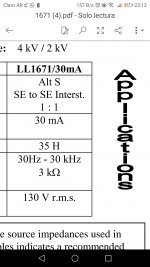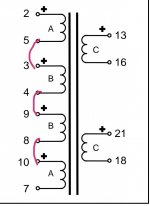The primary can act like a plate choke.
However . . .
The secondary will be unloaded.
The only "load" on the secondary is the reflected impedance from the plate of the D3A tube that is connected to the primary.
And that reflected impedance at the secondary is not 1:1 across the frequency range.
That is because there is Leakage Inductance from primary to secondary (Leakage Reactance, higher impedance at high frequencies).
Think of the secondary as a possible resonator at some frequencies.
Just try it and see (connect a square wave to the D3A grid, and look at the 'triple junction of the D3A, LL1671 IT, and the coupling capacitor').
What you see is what you get.
An amplifier's square wave response does not have to be perfect;
but that is a hotly debated issue for some people (and that subject deserves to be in another thread).
Happy building and Happy listening.
However . . .
The secondary will be unloaded.
The only "load" on the secondary is the reflected impedance from the plate of the D3A tube that is connected to the primary.
And that reflected impedance at the secondary is not 1:1 across the frequency range.
That is because there is Leakage Inductance from primary to secondary (Leakage Reactance, higher impedance at high frequencies).
Think of the secondary as a possible resonator at some frequencies.
Just try it and see (connect a square wave to the D3A grid, and look at the 'triple junction of the D3A, LL1671 IT, and the coupling capacitor').
What you see is what you get.
An amplifier's square wave response does not have to be perfect;
but that is a hotly debated issue for some people (and that subject deserves to be in another thread).
Happy building and Happy listening.
Last edited:
You can add the secondaries in series with the primaries and get a 140H 15mA choke. Worked for me with a pair of old LL1621/40mA ITs
This is the correct way of using IT transformer as plate choke. If secondary is not connected, it adds winding capacitance in parallel with primary. With windings in series, the total winding capacitance is 1/2 of primary alone.You can add the secondaries in series with the primaries and get a 140H 15mA choke. Worked for me with a pair of old LL1621/40mA ITs
sser2, and Fuling,
Correct. You properly calculated both the inductance (140H), the current (15mA), and the series connection.
santitrucco,
Because the interstage was not intended to be used that way, I still suggest:
Connect the primary and secondary in series (and noting the proper phase connections).
Then try it and see (connect a square wave to the D3A grid, and look at the 'triple junction of the D3A Plate, LL1671 IT, and the coupling capacitor').
Check the rise time, fall time, and for any ringing.
Please report back to us what you see on the square wave test.
I expect the low frequency slope will be good (140H), but put in a 10kHz square wave to test the rise and fall time and any ringing.
If you can post a screen shot of the oscilloscope waveform, that would be great.
Thanks!
I have found that different model Lundahl interstage transformers do not all have the same square wave respone characteristics.
LL1671 and LL1621 may respond the same, or they may respond differently.
Correct. You properly calculated both the inductance (140H), the current (15mA), and the series connection.
santitrucco,
Because the interstage was not intended to be used that way, I still suggest:
Connect the primary and secondary in series (and noting the proper phase connections).
Then try it and see (connect a square wave to the D3A grid, and look at the 'triple junction of the D3A Plate, LL1671 IT, and the coupling capacitor').
Check the rise time, fall time, and for any ringing.
Please report back to us what you see on the square wave test.
I expect the low frequency slope will be good (140H), but put in a 10kHz square wave to test the rise and fall time and any ringing.
If you can post a screen shot of the oscilloscope waveform, that would be great.
Thanks!
I have found that different model Lundahl interstage transformers do not all have the same square wave respone characteristics.
LL1671 and LL1621 may respond the same, or they may respond differently.
Last edited:
- Home
- Amplifiers
- Tubes / Valves
- Lundahl 1671 interestage, like plate load?

